This article has the following sections.
A Ritzian Interpretation of Variable Stars
Non-pulsating Cepheid Variables
Ritzian Gamma-Ray Bursts
Ultra High Energy Cosmic Rays
Modeling Geminga
Unsung Binaries and de Sitter's Whimsical Images?
GRB 790731 and omega Geminorum
GRB 790731 and omega Geminorum
Copyright © 2001-2004 Robert S. Fritzius
Installed 7 May 2001 - Latest Update 27 Jul 2016
Corrections or additions are in bold.
Omega Geminorum (omega Gem) was reported to be a Cepheid variable in the mid 70's(1) but in 1989 it was found to be non-variable(2). [The tone of this second reference seemed to imply that if omega Gem was not variable right then, then it never was.]
In between these studies the peculiar Gamma-ray burst, GRB 790731, occurred in close proximity to omega Gem. From a Ritzian relativity viewpoint [source velocity additive to speed of light] the time profile of GRB 790731 can be interpreted as the record of a close binary system (more likely a triplet comprised of a G5 star and two closely interacting neutron stars) undergoing a catastrophic change of state.
The following time profiles for GRB 790731 are from the Catalog of Cosmic Gamma-ray Bursts from the KONUS experimental Data, Part III. (3).
Information on the KONUS experiment is available at the Venera 11 & Venera 12 webpage, published by NASA. Prognoz 7, in Earth orbit, was used to complete a triangulation network with the Venera duo.
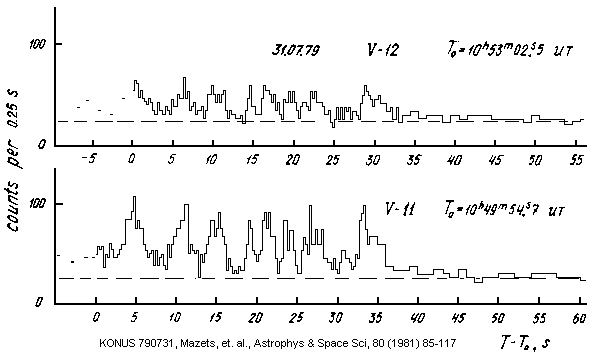
Here the profiles have been smoothed to remove the bulk of scintillation effects. The smoothing function used was:
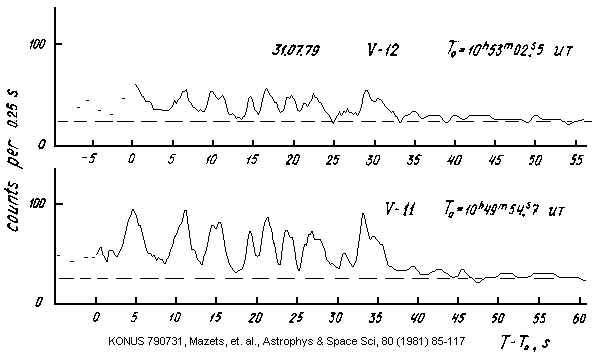
The following diagram shows the one sigma quadrangular localization box and triangulation ring for GRB 790731 on a star chart which includes omega Geminorum.
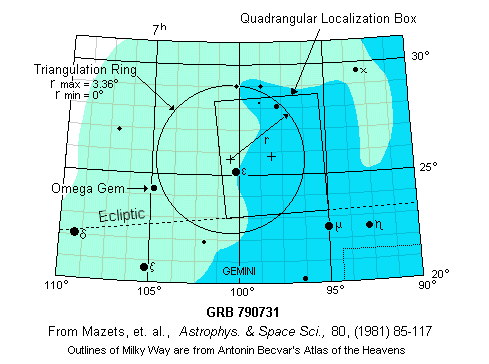
The data table in the KONUS catalog gives, for the triangulation ring, a radius of 0.66 degrees +2.7 / -0.66 degrees. This remarkably small radius must result from the burst being almost directly in line with the Venera 11 and 12 spacecraft. (All other triangulation rings in the subject study have radii ranging from 29 to 87 degrees.)
The likelihood that the line of sight to GRB 790731 was "inside" the one sigma error box, shown above, is 50 percent. If we construct a 90 percent likelihood error box box it should be about 2.5 times larger on each side than for the one sigma box. (The GRB triangulation ring almost kisses omega Gem.) The idea here is to see if omega Gem could be considered as an optical counterpart of the GRB.
The following paragraph and quote were inserted on 25 August 2002. (The delay in including this info had to do with a belief system in turmoil. There is still a problem in that department!)
On 14 May 2001 E.P. Mazets, primary investigator for the KONUS experiment, furnished the following good news - bad news regarding GRB 790731 and omega Gem.
Our data you have used are given with accuracy of one sigma. From this point of view, omega Gem lies inside both localization boxes. However, there is a third localization of GRB 790731. That is triangulation Venera 11(12) and Pioneer Venus Orbiter data. This very narrow ( +/-0.06 deg ) triangulation annulus passes about four degrees away from omega Gem.
An updated GRB 170731 localization diagram is shown here to reflect the import of Dr. Mazets' remarks. The implied radius and center of the added triangulation annulus (shown in red) are rough approximations. (Added 13 October 2002.)
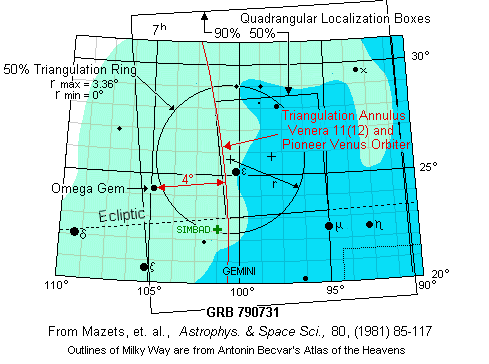
In this writer's opinion, the location of the +/-0.06 deg annulus may be questionable. (Recognition that the following argument may actually be a stalling of the invetible is also noted.) The potential problem here has to do with speed-of-light considerations. (The whole thrust of this article is that, within the confines of extinction-limited volumes of space, the velocities of sources are vectorially additive with the velocity of light.) If anybody's space platform location process involves constant speed of light beacon tracking, but c+v conditions actually exist, then we have a problem. Readers are referred to the article, Astronomical Constants and Planetary Ephemerides Deduced from Radar and Optical Observations(4). According to that study, when RADAR sites on opposite sides of Earth (U.S. and U.S.S.R.) simultaneously tracked Venus (and all three observation groups used a constant speed-of-light in their ranging calculations) there were significant opposite sides of the world differences in the measured ranges to Venus . (Added 2 Sep 2002 - Updated 22 October 2002.)
Quoting from the referenced article. "Although not apparent from inspection of Fig. 4, the residuals of the U.S.S.R. time delay data are systematically negative relative to the Arecibo and Lincoln Laboratory residuals during the time period (June 1964) when all three groups were observing Venus. This incompatibility cannot be removed by assuming simply that different units of time were used by the different observatories. The apparent discrepancy of up to five times the quoted measurement error thus remains unexplained." Ref. (4) pp. 343-344. In this author's opinion, those differences were related to c+v effects brought about by the daily rotation of Earth. Thanks to Bryan Wallace for calling attention to this information. (Added 22 October 2002.)
Getting back to Omega gem.
A literature search regarding the variability of omega Gem is in progress. If omega Gem was variable after 31 July 1979 or if it was non-variable before that date, then the premise of this investigation will be falsified. [In light of other findings, this statement turns out to be short sighted and overly restrictive. See the next two paragraphs.]
In 1998-1999 omega Gem was observed to be variable. See the 1999 VSNET Light Curve of omega Gem. (Installed on 22 August 2002.)
It turns out that there are variables whose variabilities undergo periodic changes in amplitude. Some of their long period light curves look like pulse trains being turned on and off by a longer period square wave. In other cases, part of the variability waxes and wanes very gradually, sometimes decreasing all the way to zero. Light curves for two of these varying variability variables are shown in Light Curves of Variable Stars: A Pictorial Atlas, C. Sterken, C. Jaschek (Editors), Cambridge University Press,. For HR3831, see Fig. 4.5, p. 116. For Z Cam, see Fig. 5.29, p.154.
Another line of investigation to be pursued has to do with the proper and radial motions of omega Gem before and after 31 July 1979. If the star was an intrinsically radially pulsating variable that quit pulsating (for whatever reason) we should not expect to find any change in its velocity. On the other hand, if components of multiple star system interacted catastrophically and one or more of them (dark companions) departed the pattern, so to speak, then we might expect to see a velocity change in the remaining visible component.
The author's Tribody.bas computer program has been tailored to simulate the interactions of multiple star systems (a G5 star and two neutron stars, at present). Ritz's c+v relativity has been incorporated to produce light curves suitable for evaluating the possible connection between KONUS 790731 and the cessation of the variability of omega Geminorum. This software, which is still in the "shaky" phase is downloadable as an ASCII file and can be run in Quick BASIC. You may click on O-GEM.BAS and save it for off line use.
Presently the computer code being used strictly models gravitational interactions. As a result of this, the light curve spikes (DEFG below) associated with the transitional phase (Cepheid to non-Cepheid) are time-wise much more spread out than for the nine or so spikes in 35 seconds of KONUS 790731. The time between the Cepheid-like bumps at the first (ABC)correspond to a period of approximately 17 hours (0.7 day).
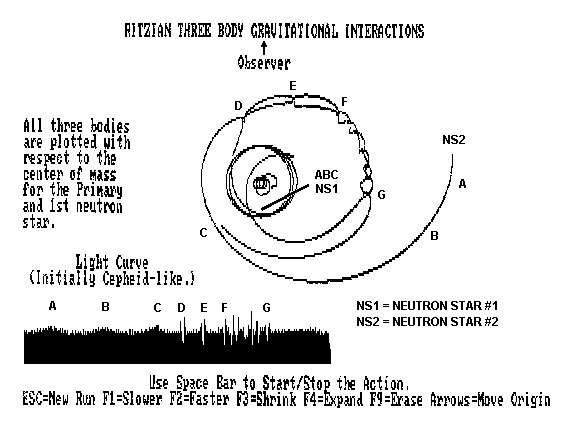
If warranted, electrodynamic interactions between the neutron stars will be added in a future version of the program.
The following section was added on 24 January 2002.
In private correspondence (12 January 2002) Göran Henriksson provided an update on further research about the pre-1976 variability of omega Gem. The following material is a thumbnail sketch of that update.
Twelve observations, up through 1975, showed a significant variation in brightness of omega Gem, with a period of about 1.2 days. (Eight other observations are presently unavailable due to a closed library.) Plots of B-V and U-B colours, as a function of V-magnitude, reveal a phase relation between omega Gem's apparent radial velocity curve and its brightness curve which is similar to that observed for long-period variables (LPVs).
[The radial velocity curves, related to absorption lines, for LPVs are flip-flopped phase-wise as compared to those for Cepheids.] See Merrill (5) and Joy (6) for some classic, but long overlooked, studies into long-period variables. (Based on an earlier reported period of 0.73 days, without a detailed colour analysis, omega Gem was originally tagged as being a Cepheid. See McMaster Cepheid Photometry and Radial Velocity Data Archive. Click on Classical Cepheids and slide down to the Gemini entries.)
[In essence, Henriksson is saying that omega Gem is not a Cepheid after all.]
Henriksson has proposed a model that omega-Gem (for the observations that he has) is/was a binary system comprised of a yellow G5Ib-II supergiant and a much smaller red companion (brighter than a red dwarf) with the red component circling inside the supergiant's atmosphere at a depth of about 10 percent of the latter's radius. (Henriksson and his colleagues at Upsalla Observatory do not believe this to be a useful model.)
Readers are invited to review Mira Variables, another subsection of this article, to examine a proposal that some stars do, in fact, plow around (sub-surface) in red giants.
References
(1) G. Henriksson, (1977) Astron & Astrophys, 54, 309.
(2) E. Poretti, et.al., (1989) Comission 27 IAU, Information Bulletin on Variable Stars Number 3300
(3) E. P. Mazets, S. V. Golenetskii, V. N. Ilyinskii, V. N. Panov, R. L. Apekar, Yu. A. Guryan, M. P. Proskura, I. A. Sokolov, Z. Ya. Sokolova, T.V. Kharitonova, A. V. Dyatchkov and Khavenson, Astrophysics and Space Science, 80, (1981) 85. - See Figure 20 on page 94.
(4) M.E. Ash, I.I. Shapiro, and W. H. Smith, The Astronomical Journal, 72, 338, 1967.
(5) P.W. Merrill, (1940) Spectra of Long-Period Variable Stars, University of Chicago Press.
(6) A.H. Joy, (1954) Ap. J. Supp. 1, 39.